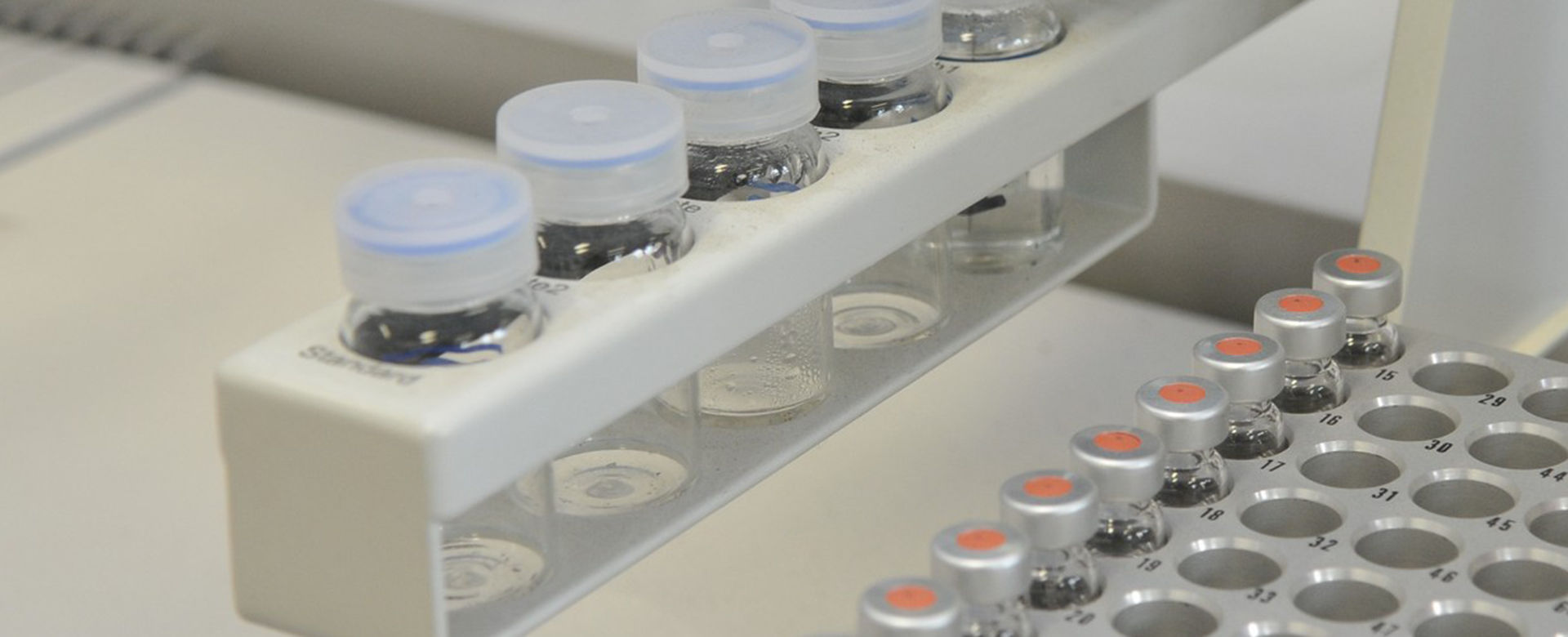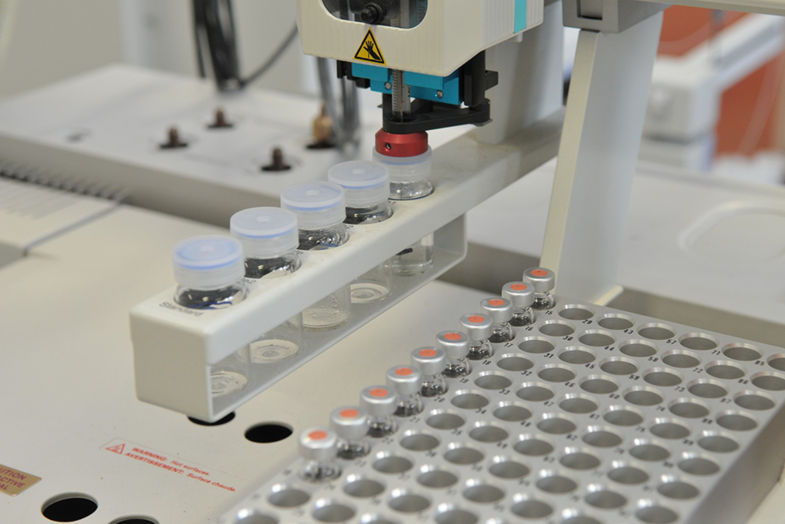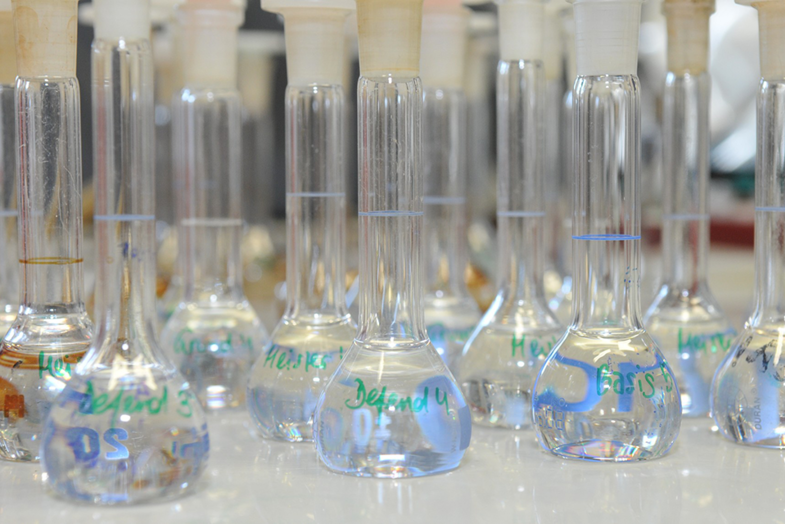Outdoor wood products, weathered or in contact with soil, are chemically protected to prevent degradation by microorganisms or infestation by insects. The range of products used ranges from aqueous or oily paints to wood preservatives for impregnation processes. We provide the chemical evidence for the correct amount of active ingredient in all of these products, as well as the products treated with them, such as poles, railway sleepers, noise barriers, decking, facades or windows. We thus enable products to have a long lifespan and support a responsible handling of biocidal products.
Wood preservatives, wood coatings and leaching
We determine the content of all common active ingredients that are used as wood preservatives, wood coatings or in wood preservative formulations, and we carry out all other physical tests such as density, viscosity and pH. We are geared towards aqueous and oily products, inorganic and organic active ingredients, as well as impregnated wood. We conduct tests on the leaching behavior of biocides based on laboratory (UBA and OECD methods) and field methods, in all sizes from products to entire constructions.
Abandoned wood preservatives
PCP and lindane are among the most prominent active ingredients that are no longer used today. We regularly inspect floors made of wood and wooden materials such as particleboard for compliance with legal limits. Other active ingredients are also being withdrawn from the market, making the detection of these biocides continually more important.
Recycling wood
Recycled wood has a variety of different applications. In addition to its use in the wood-based panel industry or as an energy source, it is also very popular as a decorative sawing product. Recycling wood products are subject to legal requirements with regard to chemical ingredients. With our analytics, we create the basis for a safe handling of this valuable raw material.
Flame retardants
Coatings or impregnations as a means of fire protection play a rather subordinate role in Austrian timber construction. In the insulation area, on the other hand, the analysis of flame retardants has become very important, especially since the HBCD ban in polystyrene. Regardless of the application, be it for current products or for recycled building materials, our analytics provide answers to the burning question of the type and amount of flame retardants.
Download Österreichisches Holzschutzmittelverzeichnis
Österreichisches Holzschutzmittel-Verzeichnis (pdf, 689 KB)
- author(s)
- publishing year
- 2024
- pages
- 79 S.

Contact persons
Active ingredient analysis, recycling wood

Recycling wood, wood technology

Our services
Quality assurance for wood preservatives
Our active ingredient verification serves the wood preservative industry in quality assurance in production and processing, as well as in the use of treated wood products.
Complaint
Inadequate wood protection, health complaints, contaminated sites, building evaluation – we clarify the type and quantity of biocides in the B2B and B2C areas. We take samples of wood, dust, soil, water on site.
Free from contaminated burdens
We guarantee compliance with legal and voluntary regulations such as a ban on chemicals, recycling-, waste wood- or landfill- ordinance, österreichisches Umweltzeichen or Blauer Engel.
Initial assessment on site
Our mobile laboratory is ideal for construction sites. Using mobile XRF, we show within a few minutes whether there are increased concentrations of selected elements in wood but also in building products such as insulating materials. In addition to wood preservatives, these can also be an indication of flame retardants.
Expert activity
We cooperatively work on uniform detection methods for active substances with companies and research institutions in the analytics working group of the RAL Gütegemeinschaft for impregnated wood construction elements.
Available infrastructure:
- Microwave digestion system: CEM MARS 6
- ASE: Thermo Fisher Scientific, ASE 350, Accelerated Solvent Extractor for gentle solvent extraction
- GC/MS/ECD/FID: Agilent, gas chromatography, mass spectrometer, electron capture detector, flame ionization detector
- GC/MS/ECD/FID: Thermo Fisher Scientific, Gas chro¬matography, mass spectrometer, electron capture detector, flame ionization detector
- HPLC/DAD: Thermo Fisher Scientific, High Performance Liquid Chromatography with diode array detector
- IC/UV/CD: Thermo Fisher Scientific, Ion Chromatography with UV and conductivity detector
- FTIR-ATR/DRIFT: Perkin Elmer, Fourier transform infrared spectrometer, attenuated total reflection and diffuse reflection for surfaces
- ICP-OES: Thermo Fisher Scientific, iCAP PRO XP Duo, inductively coupled plasma optical emission spectrometry, heavy metals, wood preservatives, fire retardants
- Mobile XRF: Spectro, Spectroscout, portable X-ray fluorescence spectrometer for elemental analysis, heavy metals, wood preservatives, fire retardants, measurement on site




















